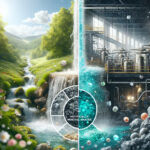-
Table of Contents
- Introduction
- Understanding the Environmental Impact of Bottling Mineral Water
- The Hidden Environmental Costs of Bottled Mineral Water
- Bottled Mineral Water: A Threat to Our Ecosystem?
- Exploring the Environmental Concerns Linked to Mineral Water Bottling
- The Role of Bottled Mineral Water in Global Plastic Pollution
- Q&A
- Conclusion
“Bottling Mineral Water: Quenching Thirst or Draining the Earth?”
Introduction
Bottling mineral water raises several environmental concerns. The process involves extraction, bottling, and transportation, each of which has a significant environmental impact. Extraction can deplete local water supplies and disrupt ecosystems, while the production and disposal of plastic bottles contribute to pollution and waste. Additionally, the transportation of bottled water over long distances results in substantial carbon emissions. Despite the perceived purity and health benefits of bottled mineral water, these environmental issues present a serious challenge to its sustainability.
Understanding the Environmental Impact of Bottling Mineral Water

Bottling mineral water is a common practice worldwide, with millions of people relying on it for their daily hydration needs. However, as we quench our thirst, it’s crucial to consider the environmental implications of this seemingly harmless activity. The process of bottling mineral water, from extraction to disposal, has a significant environmental footprint that often goes unnoticed.
To begin with, the extraction of mineral water from natural sources can lead to the depletion of these resources. Natural springs and underground aquifers are the primary sources of mineral water. Over-extraction can lead to a decrease in the water table, causing wells to dry up and affecting the availability of water for other uses. Moreover, the extraction process can disrupt local ecosystems, affecting the flora and fauna that depend on these water sources.
Once the water is extracted, it must be transported to the bottling facilities. This transportation often involves long distances, especially when the water is sourced from remote or exotic locations. The use of trucks, ships, and planes for transportation contributes to greenhouse gas emissions, which are a significant driver of climate change. Furthermore, the energy consumed during the transportation process adds to the overall carbon footprint of bottled mineral water.
The bottling process itself also has environmental implications. The production of plastic bottles requires petroleum, a non-renewable resource. The manufacturing process also releases harmful emissions into the atmosphere, contributing to air pollution. Additionally, the energy consumed during the production and filling of the bottles further increases the environmental impact.
However, the environmental concerns with bottling mineral water do not end once the water reaches the consumer. After consumption, the disposal of the plastic bottles poses a significant environmental challenge. While recycling is an option, the sad reality is that a large percentage of plastic bottles end up in landfills or, worse, in our oceans. These discarded bottles take hundreds of years to decompose, during which they release harmful chemicals into the soil and water. Moreover, they pose a threat to marine life, which often mistake the plastic for food.
In addition to the direct environmental impact, the bottling of mineral water also has indirect effects. For instance, the promotion of bottled water can undermine confidence in tap water, leading to increased consumption of bottled water and, consequently, more plastic waste. Furthermore, the privatization of water sources for bottling can restrict access to clean water for local communities, leading to social and economic disparities.
In conclusion, while bottled mineral water may be a convenient choice for hydration, it carries with it a significant environmental cost. From the depletion of natural resources and greenhouse gas emissions to plastic pollution and social inequity, the environmental concerns associated with bottling mineral water are manifold. As consumers, it’s essential to be aware of these impacts and consider more sustainable alternatives, such as using refillable water bottles and supporting improvements in public water infrastructure. After all, every small step towards sustainability can make a big difference in preserving our planet for future generations.
The Hidden Environmental Costs of Bottled Mineral Water
Bottled mineral water is a popular choice for many people worldwide, valued for its perceived purity and health benefits. However, beneath the surface of this seemingly harmless product lies a series of environmental concerns that are often overlooked. The production, transportation, and disposal of bottled mineral water contribute significantly to environmental degradation, making it a less sustainable choice than it appears.
The environmental impact of bottled mineral water begins with its production. The process of extracting, bottling, and packaging water is energy-intensive. It involves the use of heavy machinery to drill into the earth’s crust, pump out the water, and transport it to the bottling facility. This process consumes a significant amount of fossil fuels, contributing to greenhouse gas emissions and global warming.
Moreover, the bottles themselves are typically made from plastic, a material derived from petroleum. The production of plastic bottles requires a substantial amount of energy and releases harmful pollutants into the atmosphere. In fact, according to the Pacific Institute, the energy required to produce the plastic bottles for American consumption alone is equivalent to the annual fuel use of more than 1 million cars.
The transportation of bottled mineral water also has a considerable environmental footprint. Often, the water is not sourced locally but is instead shipped from distant locations. This long-distance transportation requires a significant amount of fuel, contributing further to greenhouse gas emissions. Additionally, the heavy weight of water increases the energy required for transportation, making it one of the most energy-intensive products to transport.
Once consumed, the disposal of bottled mineral water presents another set of environmental challenges. Despite recycling efforts, a large proportion of plastic bottles end up in landfills or, worse, in our oceans. These bottles take hundreds of years to decompose, during which time they release toxic chemicals into the soil and water. Furthermore, the decomposition process of plastic produces methane, a potent greenhouse gas that contributes to climate change.
Even when bottles are recycled, the process is not without its environmental costs. Recycling requires energy for the collection, transportation, and processing of the bottles. Moreover, the recycling process itself can release harmful pollutants into the environment.
In addition to these direct environmental impacts, the bottling of mineral water can have indirect effects on local ecosystems. The extraction of water can deplete local water sources, affecting both human communities and wildlife. In some cases, it can even lead to the drying up of springs and wells, disrupting the natural water cycle.
In conclusion, while bottled mineral water may seem like a clean, healthy choice, it carries with it a significant environmental cost. From the energy-intensive production and transportation processes to the pollution caused by disposal and recycling, the environmental footprint of bottled mineral water is substantial. As consumers, it is crucial to be aware of these hidden costs and to consider more sustainable alternatives, such as using refillable water bottles and supporting local water sources. By making informed choices, we can help to reduce the environmental impact of our consumption and contribute to a more sustainable future.
Bottled Mineral Water: A Threat to Our Ecosystem?
Bottled mineral water is a common sight in our daily lives. It’s in our homes, offices, and even in our bags when we’re on the go. It’s a symbol of convenience and health, providing us with essential minerals and hydration. However, beneath the surface of this seemingly harmless product, there are significant environmental concerns that we need to address.
The process of bottling mineral water begins with extraction. This involves drilling into underground water sources, which can lead to a decrease in the water table and cause droughts in surrounding areas. Moreover, the extraction process can disrupt the natural flow of water, affecting local ecosystems and wildlife. It’s also worth noting that the extraction of mineral water is often unregulated, leading to over-extraction and further environmental damage.
Once the water is extracted, it needs to be transported to the bottling facilities. This transportation process contributes to air pollution and global warming due to the carbon emissions from the vehicles used. Furthermore, the energy consumed during this process, from fuel for transportation to electricity for machinery, contributes to our overall energy consumption and carbon footprint.
The next step in the process is bottling. The majority of mineral water bottles are made from plastic, a material that poses a significant threat to our environment. Plastic production involves the use of fossil fuels, which are non-renewable resources. The production process also releases harmful greenhouse gases into the atmosphere, contributing to climate change.
The environmental impact of plastic doesn’t end with production. Once the water is consumed, the plastic bottles often end up in landfills or, worse, in our oceans. It’s estimated that up to 8 million metric tons of plastic waste enter our oceans each year, posing a threat to marine life and ecosystems. Plastic takes hundreds of years to decompose, and as it breaks down, it releases toxic chemicals into the soil and water.
Recycling is often touted as the solution to our plastic problem. However, the reality is that only a small percentage of plastic bottles are actually recycled. Even when they are, the recycling process itself consumes energy and releases greenhouse gases. Moreover, each time plastic is recycled, its quality degrades, meaning it can only be recycled a limited number of times before it ends up as waste.
In addition to the environmental concerns, there are also social implications to consider. In many parts of the world, access to clean water is a significant issue. Yet, companies are able to extract and sell water, often at high prices, while local communities struggle to access this basic necessity.
In conclusion, while bottled mineral water may offer convenience and health benefits, it’s clear that it also poses significant environmental threats. From extraction to disposal, each step in the process contributes to environmental degradation and climate change. As consumers, we need to be aware of these impacts and consider more sustainable alternatives, such as using refillable water bottles and supporting companies that prioritize sustainability. After all, our choices today will shape the health of our planet for future generations.
Exploring the Environmental Concerns Linked to Mineral Water Bottling
Mineral water, a staple in many households, is often seen as a healthier alternative to tap water due to its natural mineral content. However, the process of bottling this water and getting it to consumers’ homes raises several environmental concerns.
The first concern is the extraction of water. Mineral water is sourced from natural springs, which are often located in environmentally sensitive areas. The extraction process can disrupt local ecosystems, deplete water resources, and cause land subsidence. In some cases, the extraction of water can even lead to the drying up of springs, which can have devastating effects on local flora and fauna.
Once the water is extracted, it must be transported to the bottling facility. This transportation process often involves large trucks, which emit significant amounts of greenhouse gases. These emissions contribute to climate change, which is one of the most pressing environmental issues of our time.
The bottling process itself also has environmental implications. The bottles are typically made from plastic, which is derived from fossil fuels. The production of plastic bottles requires a significant amount of energy and releases harmful emissions into the atmosphere. Furthermore, the use of plastic contributes to the global plastic waste problem.
Despite recycling efforts, a large proportion of plastic bottles end up in landfills or in the ocean. These bottles take hundreds of years to decompose, during which time they can harm wildlife and pollute the environment. In the ocean, plastic bottles can break down into microplastics, tiny particles that are ingested by marine life and can make their way up the food chain, potentially impacting human health.
Moreover, the transportation of bottled water from the bottling facility to retail outlets and then to consumers’ homes further adds to the carbon footprint of bottled water. This is particularly true for imported mineral water, which may travel thousands of miles before reaching the consumer.
In addition to these direct environmental impacts, the bottling of mineral water also has indirect effects. For example, the promotion of bottled water can contribute to a culture of disposability, where items are used once and then thrown away. This culture is a major driver of the global waste problem.
Furthermore, the marketing of bottled water often implies that it is superior to tap water, which can undermine public confidence in tap water and lead to underinvestment in public water infrastructure. This can have serious implications for access to clean water, particularly in low-income communities.
In conclusion, while mineral water may have health benefits, the process of bottling and distributing it raises several environmental concerns. These include the depletion of water resources, the emission of greenhouse gases, the production of plastic waste, and the promotion of a culture of disposability. As consumers, it is important to be aware of these impacts and to consider them when making purchasing decisions. One way to mitigate these impacts is to choose tap water where it is safe to do so, and to use reusable water bottles instead of disposable ones.
The Role of Bottled Mineral Water in Global Plastic Pollution
Bottled mineral water is a staple in many households worldwide. It’s convenient, easily accessible, and often perceived as a healthier alternative to tap water. However, the environmental impact of this seemingly harmless product is a growing concern. The role of bottled mineral water in global plastic pollution is significant and warrants our attention.
The production of bottled mineral water begins with the extraction of water from natural springs or wells. This process can lead to the depletion of local water resources, affecting the availability of water for local communities and ecosystems. Moreover, the extraction process can also disrupt the natural flow of water bodies, potentially harming aquatic life.
Once the water is extracted, it is transported to bottling facilities, often located far from the source. This transportation contributes to greenhouse gas emissions, further exacerbating climate change. The water is then packaged in plastic bottles, which are made from petroleum-based products. The production of these bottles requires a significant amount of energy and releases harmful emissions into the atmosphere.
The environmental impact of bottled mineral water does not end with its production. Once consumed, the plastic bottles often end up in landfills or, worse, in our oceans. It is estimated that a staggering one million plastic bottles are bought every minute globally, and less than half of these are collected for recycling. Even when collected, only a small fraction is effectively recycled, with the rest ending up in landfills or the natural environment.
Plastic bottles take hundreds of years to decompose, during which they release harmful chemicals into the soil and water. When they end up in the ocean, they break down into microplastics, tiny particles that are ingested by marine life, entering the food chain and potentially ending up on our plates.
Moreover, the recycling process itself is not without environmental impact. It requires energy and water, and it often involves the release of harmful emissions. Furthermore, due to the low value of recycled plastic, many bottles are shipped to developing countries for recycling, contributing to further greenhouse gas emissions.
The environmental concerns associated with bottling mineral water are undeniable. However, it’s important to note that the responsibility does not lie solely with the producers. As consumers, we play a crucial role in this issue. By choosing to drink tap water when safe, using reusable water bottles, and properly disposing of plastic waste, we can significantly reduce the demand for bottled mineral water and, consequently, the associated environmental impact.
In conclusion, while bottled mineral water may seem like a convenient and healthy choice, it carries a significant environmental cost. From the depletion of natural resources and the release of greenhouse gases to the production of plastic waste and its impact on marine life, the role of bottled mineral water in global plastic pollution is substantial. As consumers, we need to be aware of these impacts and make informed choices to reduce our contribution to this global issue.
Q&A
1. Question: What are the environmental impacts of bottling mineral water?
Answer: The environmental impacts of bottling mineral water include excessive water extraction, energy consumption during production and transportation, and plastic waste generation.
2. Question: How does the extraction of mineral water affect the environment?
Answer: The extraction of mineral water can lead to water scarcity in certain regions, disrupt local ecosystems, and cause land subsidence.
3. Question: How does the production of plastic bottles for mineral water affect the environment?
Answer: The production of plastic bottles for mineral water consumes large amounts of energy and releases harmful greenhouse gases. Additionally, plastic bottles are non-biodegradable and contribute to plastic pollution.
4. Question: What is the impact of transporting bottled mineral water on the environment?
Answer: Transporting bottled mineral water contributes to carbon emissions, which exacerbate climate change. It also consumes significant amounts of fossil fuels.
5. Question: Are there any solutions to mitigate the environmental concerns associated with bottling mineral water?
Answer: Solutions include promoting the use of reusable bottles, improving recycling rates, reducing the amount of plastic used in bottles, and sourcing water locally to reduce transportation emissions.
Conclusion
Yes, there are several environmental concerns with bottling mineral water. These include the depletion of natural resources, pollution from manufacturing and transportation of bottles, and the creation of plastic waste, as most bottled waters are packaged in non-biodegradable plastic bottles. Additionally, the recycling rate of these bottles is low, leading to significant waste accumulation in landfills and oceans.







